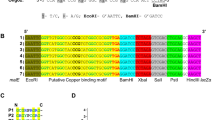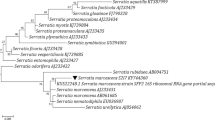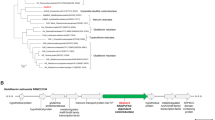Abstract
Here we describe targeting of the mouse metallothionein I (MT) protein to the cell surface of the heavy metal-tolerant Ralstonia eutropha (formerly Alcaligenes eutrophus) CH34 strain, which is adapted to thrive in soils highly polluted with metal ions. DNA sequences encoding MT were fused to the autotransporter β-domain of the IgA protease of Neisseria gonorrhoeae, which targeted the hybrid protein toward the bacterial outer membrane. The translocation, surface display, and functionality of the chimeric MTβ protein was initially demonstrated in Escherichia coli before the transfer of its encoding gene (mtb) to R. eutropha. The resulting bacterial strain, named R. eutropha MTB, was found to have an enhanced ability for immobilizing Cd2+ ions from the external media. Furthermore, the inoculation of Cd2+-polluted soil with R. eutropha MTB decreased significantly the toxic effects of the heavy metal on the growth of tobacco plants (Nicotiana bentamiana).
This is a preview of subscription content, access via your institution
Access options
Subscribe to this journal
Receive 12 print issues and online access
$209.00 per year
only $17.42 per issue
Buy this article
- Purchase on Springer Link
- Instant access to full article PDF
Prices may be subject to local taxes which are calculated during checkout




Similar content being viewed by others

References
de Lorenzo, V. & Kuenen, G. Scientific basis for the remediation of the toxic spill of Aznalcóllar mine: combining bacteria and plants to address an intractable kind of pollution. Environ. Microbiol. 1, 275–278 (1999).
Grimalt, J.O., Ferrer, M. & Macpherson, E. The mine tailing accident in Aznalcollar. Sci. Total Environ. 242, 3–11 (1999).
Lovley, D.R. & Coates, J.D. Bioremediation of metal contamination. Curr. Opin. Biotechnol. 8, 285–289 (1997).
Gadd, G.M. & White, C. Microbial treatment of metal pollution—a working biotechnology? Trends Biotechnol. 11, 353–359 (1993).
Chaney, R.L. et al. Phytoremediation of soil metals. Curr. Opin. Biotechnol. 8, 279–284 (1997).
Kratochvil, D. & Volesky, B. Advances in the biosorption of heavy metals. Trends Biotechnol. 16, 291–300 (1998).
Nordberg, M. Metallothioneins: historical review and state of knowledge. Talanta 46, 243–254 (1998).
Sousa, C., Kotrba, P., Ruml, T., Cebolla, A. & Lorenzo, V.d. Metalloadsorption by Escherichia coli cells displaying yeast and mammalian metallothioneins anchored to the outer membrane protein LamB. J. Bacteriol. 180, 2280–2284 (1998).
Valls, M., González-Duarte, R., Atrian, S. & Lorenzo, V.D. Bioaccumulation of heavy metals with proteins fusions of metallothionein to bacterial OMPs. Biochimie 80, 855–861 (1998).
Mergeay, M. et al. Alcaligenes eutrophus CH34 is a facultative chemolitotroph with plasmid-bound resistance to heavy metals. J. Bacteriol. 162, 328–334 (1985).
Henderson, I.R., Navarro-Garcia, F. & Nataro, J.P. The great escape: structure and function of the autotransporter proteins. Trends Microbiol. 6, 370–378 (1998).
Pohlner, J., Halter, R., Beyreuther, K. & Meyer, T.F. Gene structure and extracellular secretion of Neisseria gonorrhoeae IgA protease. Nature 325, 458–462 (1987).
Klauser, T., Krämer, J., Otzelberger, K., Pohlner, J. & Meyer, T.F. Characterization of the Neisseria Igaβ-core. The essential unit for outer membrane targeting and extracellular protein secretion. J. Mol. Biol. 234, 579–593 (1993).
Veiga, E., De Lorenzo, V. & Fernandez, L.A. Probing secretion and translocation of a beta-autotransporter using a reporter single-chain Fv as a cognate passenger domain. Mol. Microbiol. 33, 1232–1243 (1999).
de Lorenzo, V. & Timmis, K.N. Analysis and construction of stable phenotypes in Gram-negative bacteria with Tn5- and Tn10-derived minitransposons. Methods Enzymol. 235, 386–405 (1994).
Bardwell, J.C.A. Building bridges: disulphide bond formation in the cell. Mol. Microbiol. 14, 199–205 (1994).
Jose, J., Krämer, J., Klauser, T., Pohlner, J. & Meyer, T.F. Absence of periplasmic DsbA oxidoreductase facilitates export of cysteine-containing passenger proteins to the Escherichia coli cell surface via the Igaβ autotransporter pathway. Gene 178, 107–110 (1996).
Bardwell, J.C.A., McGovern, K. & Beckwith, J. Identification of a protein required for disulfide bond formation in vivo. Cell 67, 581–589 (1991).
Tibazarwa, C., Wuertz, S., Mergeay, M., Wyns, L. & van Der Lelie, D. Regulation of the cnr cobalt and nickel resistance determinant of Ralstonia eutropha (Alcaligenes eutrophus) CH34. J. Bacteriol. 182, 1399–1409 (2000).
Ramos, J.L. & Marqués, S. Transcriptional control of the Pseudomonas TOL plasmid catabolic operons is achieved through an interplay of host factors and plasmid-encoded regulators. Ann. Rev. Microbiol. 51, 341–373 (1997).
Diels, L., Dong, Q., van der Lelie, D., Baeyens, W. & Mergeay, M. The czc operon of Alcaligenes eutrophus CH34: from resistance mechanims to the removal of heavy metals. J. Indust. Microbiol. 14, 142–153 (1995).
Diels, L., De Smet, M., Hooyberghs, L. & Corbisier, P. Heavy metals bioremediation of soil. Mol. Biotechnol. 12, 149–158 (1999).
Ouzounidou, G., Moustakas, M. & Eleftheriou, E.P. Physiological and ultrastructural effects of cadmium on Wheat (Triticum aestivum L.) leaves. Arch. Environ. Contam. Toxicol. 32, 154–160 (1997).
Van Roy, S., Peys, K., Dresselaers, T. & Diels, L. The use of Alcaligenes eutrophus biofilm in a membrane bioreactor for heavy metal recovery. Res. Microbiol. 148, 526–528 (1997).
Nies, D.H. & Silver, S. Plasmid-determined inducible efflux is responsible for resistance to cadmium, zinc, and cobalt in Alcaligenes eutrophus. J. Bacteriol. 171, 896–900 (1989).
Mergeay, M. Towards an understanding of the genetics of bacterial metal resistance. Trends Biotechnol. 9, 17–24 (1991).
Sousa, C., Cebolla, A. & de Lorenzo, V. Enhanced metalloadsorption of bacterial cells displaying poly-His peptides. Nat. Biotechnol. 14, 1017–1020 (1996).
Gilis, A. et al. Effect of the siderophore alcaligin E on the bioavailability of Cd to Alcaligenes eutrophus CH34. J. Ind. Microbiol. Biotechnol. 20, 61–68 (1998).
Miller, J.H. A short course in bacterial genetics: a laboratory manual and handbook for Escherichia coli and related bacteria. (Cold Spring Harbor Laboratory Press, Cold Spring Harbor, New York; 1992).
Ausubel, F.M. et al. Current protocols in molecular biology. (John Wiley & Sons, New York, NY; 1994).
de Lorenzo, V., Fernandez, S., Herrero, M., Jakubzik, U. & Timmis, K.N. Engineering of alkyl- and haloaromatic-responsive gene expression with mini-transposons containing regulated promoters of biodegradative pathways of Pseudomonas. Gene 130, 41–46 (1993).
Nikaido, H. Isolation of outer membranes. Methods Enzymol. 235, 225–234 (1994).
Acknowledgements
We thank Jon Beckwith and Max Mergeay for materials and strains used in this work, Sofía Fraile for her excellent technical work, and N. van der Lelie for inspiring discussions. We are grateful to Roser Gonzàlez-Duarte for her participation and continuous support to this work. M.V. held a predoctoral fellowship from the Generalitat de Catalunya (Spain). This work was supported in part by EU contracts BIO4-CT97-2123 and BIO4-CT97-2183 and by the Spanish CICYT grants BIO98-0808 and PB96-0225.
Author information
Authors and Affiliations
Corresponding author
Rights and permissions
About this article
Cite this article
Valls, M., Atrian, S., de Lorenzo, V. et al. Engineering a mouse metallothionein on the cell surface of Ralstonia eutropha CH34 for immobilization of heavy metals in soil. Nat Biotechnol 18, 661–665 (2000). https://doi.org/10.1038/76516
Received:
Accepted:
Issue Date:
DOI: https://doi.org/10.1038/76516
This article is cited by
-
Construction of Cupriavidus necator displayed with superoxide dismutases for enhanced growth in bioelectrochemical systems
Bioresources and Bioprocessing (2023)
-
Microbial bioremediation as a tool for the removal of heavy metals
Bulletin of the National Research Centre (2023)
-
Bioremediation of Heavy Metals by Rhizobacteria
Applied Biochemistry and Biotechnology (2023)
-
Recent advances in bacterial biosensing and bioremediation of cadmium pollution: a mini-review
World Journal of Microbiology and Biotechnology (2022)
-
Novel strategies and advancement in reducing heavy metals from the contaminated environment
Archives of Microbiology (2022)


